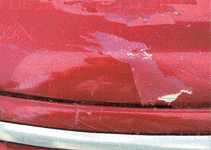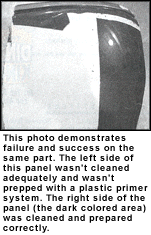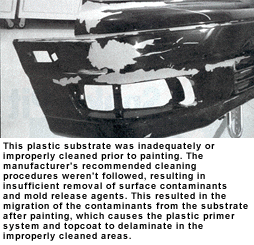Most of us baby boomers can remember this particular scene from “The Graduate”: Benjamin Braddock, played by Dustin Hoffman, has just returned home from school, having graduated with honors from college but with no idea of what to do with his life. While relaxing in his parents’ pool, he has the following conversation with his father’s best friend, Mr. McGuire.
Mr. McGuire: I just want to say one word to you — just one word.

Benjamin Braddock: Yes, sir.
Mr. McGuire: Are you listening?
Benjamin Braddock: Yes, sir I am.
Mr. McGuire: Plastics.
That was in 1967. And while the word “plastics” might not have meant much to Benjamin Braddock (or at least, not as much as Mrs. Robinson did), that word would come to revolutionize the automotive industry. For it was in the 1960s that automotive manufacturers began using more and more plastic in their vehicles. In 1970, the average vehicle in North America contained less than 70 pounds of plastic. Today, it’s up to 257 pounds. What does this mean? Plastic is displacing metal alloys in modern car design and manufacturing, and its use will continue to rise – meaning the number of times you’ll be refinishing plastic will also continue to rise.
A Quick Primer on Painting Plastic
As plastic becomes more of a fundamental component in today’s vehicles, it’s important for collision repair facilities to be aware of the proper methods of refinishing plastic parts. Though many repairers are intimidated by the thought of painting plastic, it’s really no different from painting metal – the process is essentially the same, but the products are different.
Though both processes are similar, plastic refinishing does present its own set of challenges. Poor adhesion is the most common challenge and can be attributed to poor wettability. Wettability is the process where a liquid interacts with a solid. In the refinishing process, it involves bringing liquid paint into contact with the plastic substrate, displacing air and moisture while absorbing the paint onto the surface.
Wetting is a necessary condition for good adhesion to plastic substrates. However, many plastics are difficult to wet because of the mold release agents, plasticizers and other additives that may come to the surface. Other common contaminants that cause surface wetting problems include particulates from finishing and sanding dust, as well as typical handling soils from dirty, oily or greasy hands.
To improve plastic adhesion, two techniques are recommended: proper surface pre-treatment and plastic adhesion promoters. Pre-treatments include a thorough cleaning and, depending on the paint system used, “stoving” (baking) of the plastic part. This forces contaminants to the surface of the plastic part — where they can then be removed during the cleaning process. Stoving isn’t always necessary. In fact, it can cause deformation of the plastic part because the baking temperatures are so high. Follow the paint manufacturer’s recommendations when stoving is required. In most cases, thorough cleaning is the only necessary pre-treatment.
At the Car Wash
The most essential step in painting plastic is the cleaning process because it will set the stage for success or failure. Cleaning not only removes surface contaminants, but will also create a uniform surface for improved wetting and adhesion of the coating to the plastic surface. Improper cleaning will lead to common problems, including orange peel, cratering and delamination of the coating system.
Because contaminants are either water-soluble or solvent-soluble – not both – there are two recommended cleaning methods. The first is aqueous-based soap and water cleaning, and the second is solvent-based cleaning. Most paint manufacturers offer specific products for this purpose.
Remember that cleaning shouldn’t be restricted to only the front surface of the plastic part. All surfaces should be cleaned to reduce “transfer” of contaminants back to the surface. For example, when painting a bumper, the backside should be cleaned as thoroughly as the front side.

Why Use a Plastic Adhesion Promoter?
Adhesion to plastic substrates is obtained through a chemical – rather than a mechanical – process. In the case of a coated substrate that’s cured (OE refinish, OE E-coat, cured primers), adhesion can be obtained by sanding the substrate and from the resin system of the coating being applied. The sand scratches left behind allow the subsequent coating to “grip” as the coating wicks into these scratches. This same mechanical adhesion really cannot be achieved with most plastics. No matter how aggressive the sand scratch, the exposed surface of that scratch is still plastic. In this case, a plastic adhesion promoter is required to achieve a chemical bond.
Adhesion promoters are specialized primers that are applied to provide both adhesion to the plastic substrate and a paintable surface for subsequent topcoats. Plastic adhesion promoters are designed to be highly compatible with plastic substrates. Chemically speaking, there are common polar groups in both the plastic adhesion promoter and the plastic substrates that aid in the formation of adhesive bonds. This allows for absorption of the adhesion promoter into the plastic substrate, improving the adhesion of the subsequent topcoat system.
Plastic adhesion promoters are very sensitive to film build. Performance properties are sacrificed when too much or too little material is applied. If too little is applied, the topcoat won’t adhere to the plastic. If too much is applied, the adhesion promoter will crack due to its lack of film integrity. Adhesion promoters are normally applied at a dry film thickness of between 0.1 to 0.4 mils. Again, it’s important to closely follow paint manufacturers’ recommendations when applying plastic adhesion promoters. Most paint manufacturers offer plastic adhesion promoters designed to work with their undercoat and topcoat systems. It’s especially important to understand this relationship and to stay within the paint manufacturer’s products and recommendations.
Identifying Plastic Substrates
In the past, it was important to identify the type of plastic before painting — TPO, PP, EP, PUR and others. Burning a small piece of the plastic or “floating” it in water were two methods used to identify specific plastic substrates.
Today, however, plastic adhesion promoters made for the aftermarket are designed to work universally over most types of plastic substrate. The OEMs dictate stringent adhesion specifications for automotive exterior applications, so today’s adhesion promoters are designed to meet these challenges and are universally compatible with most plastics. Follow your specific paint manufacturer’s recommendations regarding suitable plastic substrates when applying these products.
Primed Parts
Up to this point, we’ve discussed raw, “unprimed” plastic substrates. But there are also parts that come from the OE or aftermarket pre-primed, and these parts pose their own challenges.
When refinishing these parts, the factory primer can be susceptible to recoat lifting. This occurs when the coating on the item is partially soluble and partially insoluble (a soluble substrate is one that will return to its original liquid state when solvent is applied). Solvents will dissolve the soluble portion and lift the insoluble portion.
To prepare for this situation, test the plastic primer for solubility and recoat lift potential prior to refinishing. Simply apply a solvent-soaked rag on the primer in a non-conspicuous area, like the backside of a bumper, for 15 to 30 seconds. If the coating lifts, it must be removed to make an acceptable repair. Remove the affected coating and follow the paint manufacturer’s plastic refinishing recommendations for bare plastic substrates.
Remember that it can sometimes be difficult to determine whether or not a part is pre-primed. A black bumper with a black factory primer is an example of this challenge. Some of the plastic primers used today are slightly rubbery and can appear to be bare plastic. Overspray on the back side of the part isn’t always evident. To properly identify if the part is primed or bare plastic, sand a small portion of the part in a non-conspicuous area, looking for primer sanding residue and/or discoloration when sanding through the primer to the raw plastic. A rag soaked in solvent can also be applied to check for solubility.

The Future of Plastic Plastics
Plastics are the best alternative lifecycle materials available, so expect to see an increasing number of plastic parts on cars in the future. In fact, auto manufacturers are already expanding their plastic parts – from small bumpers to large van side panels.
Success in refinishing plastics is dependent on understanding their characteristics and the reasons for success and failure. And, as always, it’s best to follow the paint manufacturer’s recommendations from start to finish to ensure the highest rate of success.
As Mr. McGuire told Benjamin Braddock in 1967, the future is in plastics.
Writer Ken Phillips is product specialist, vehicle repair for Sherwin-Williams Automotive Finishes Corp.
Photos courtesy of Sherwin-Williams.
|
Why Plastics Are Popular
|













